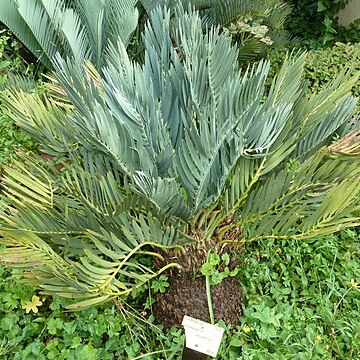Plants branching from the base; stems unbranched, up to 80-120 cm tall, 25-30 cm diam., with soft corky leaf bases; bracts buff coloured, woolly, 30-60 mm long. Leaves 60-80 cm long, mostly twisted and recurved, glaucous green, with silvery grey bloom when young; nascent leaves covered with long, silvery hairs; pulvinus brown, slightly woolly; rhachis nude for a considerable distance from its base; leaflets lanceolate, acute with a simple, pungent apex, 12-1 6 cm long, 12-14 mm broad, reduced abruptly to one or two prickles towards the petiole base, margins entire or occasionally with 1-2 teeth on lower margin only; disposition of leaflets V-shaped and lax; terminal leaflets abruptly reduced in size, giving the leaf a somewhat truncated appearance. Male cones 1-3 together from apex of stem, subcylindrical, 35-50 cm long, 50-85 mm diam., their peduncles ca 95 mm long; microsporophylls rather loosely disposed, the median 40-45 mm long, 24-28 mm broad, truncate at base, the microsporangia extending almost to the margins and to within ca 5 mm from the terminal facet, upper surface flat with vague keel; bulla glabrous, projecting about 12 mm, ca 25 mm broad and 15 mm thick, its upper surface triangular in section, extending laterally into stout wings; terminal facet 18 mm laterally and 8 mm vertically, slightly concave. female cones solitary, from the apex of the stems on a 40-50 mm long peduncle which is completely hidden by the bracts, stout, barrel-shaped, apically rather truncate, 45-50 cm long, 25 cm diam., blue green with a distinct glaucous bloom turning yellowish at maturity; median scales 70-80 mm long, the bulla glabrous, protruding about 15 mm, 60 mm broad, 40 mm thick, with lateral ridges on upper facet, extending into somewhat incurved lobes which are ca 15 mm long, the upper facet irregularly triangular in section, with one transverse ridge, its surface rough; lower facet receding at right angles from the terminal facet which is ca 40 mm broad and 25 mm wide vertically, irregularly pentagonal, concave, rather rough, with prominent, irregular denticulate margin.
More
Stems unbranched, up to 1.2 m high, 250-300 mm in diameter. Crown densely covered with soft, buff-coloured woolly bracts, 30-60 mm long. Leaves 600-800 mm long, mostly twisted and recurved, glaucous green. Petiole 90-140 mm long. Leaflets 120-160 x 12-14 mm.


